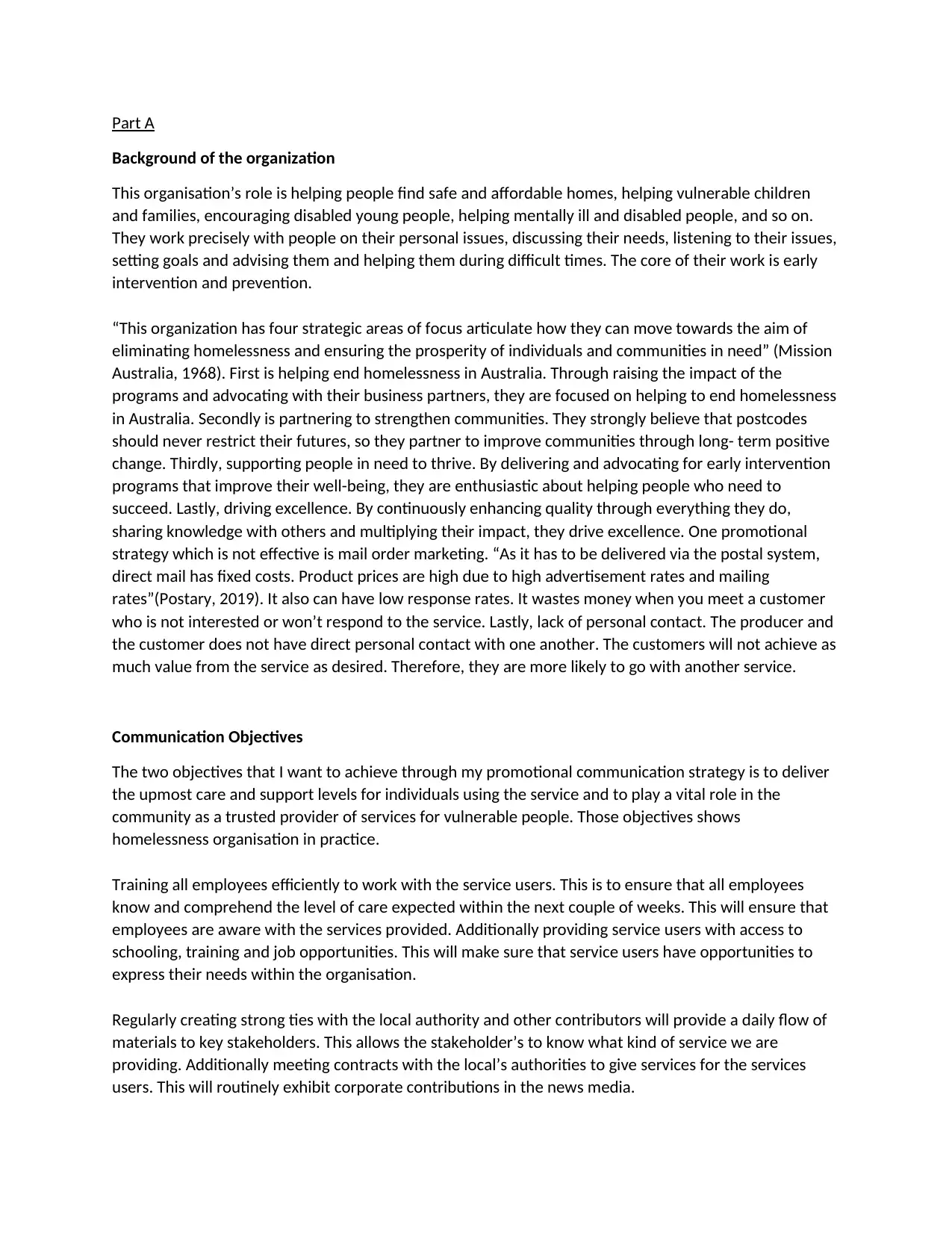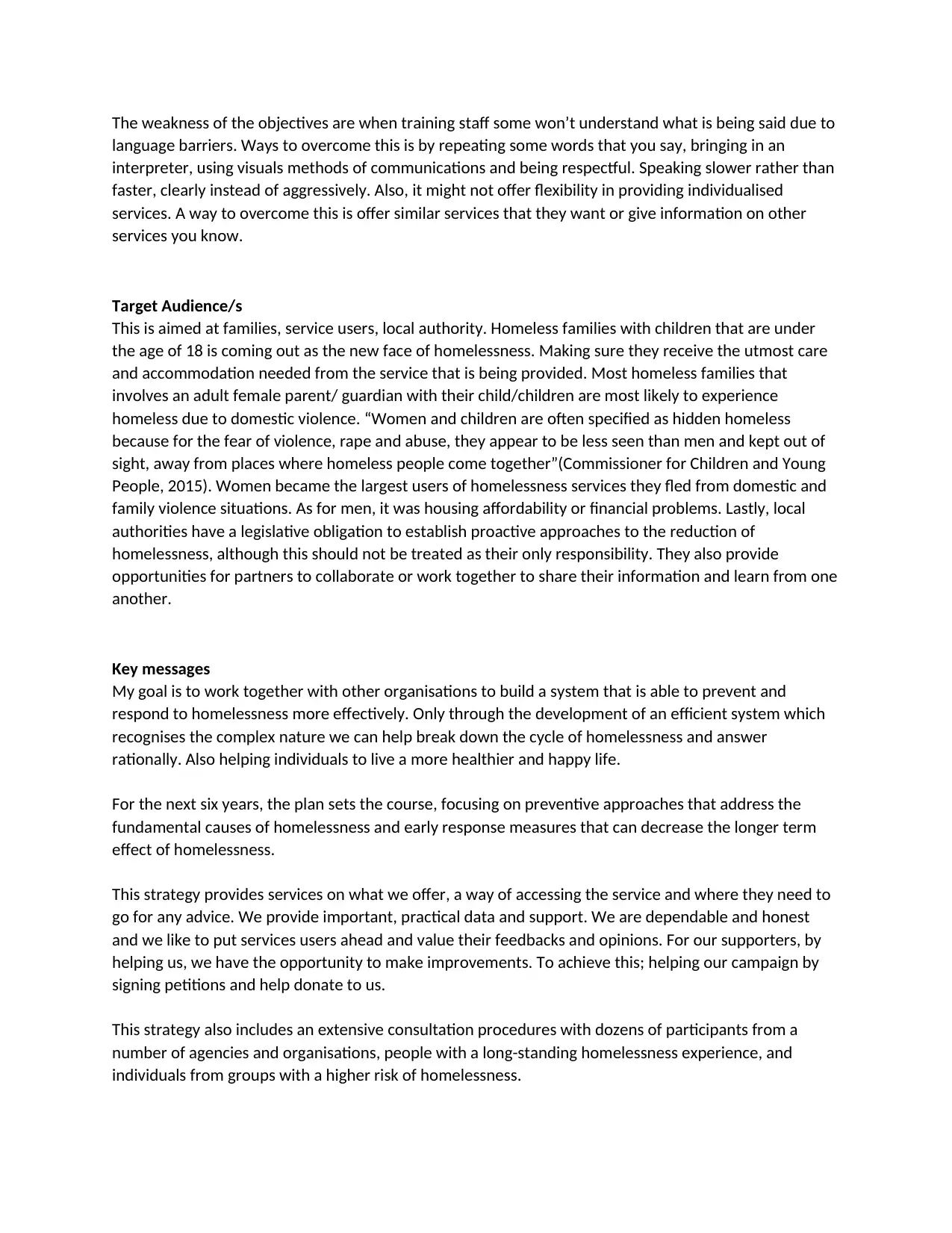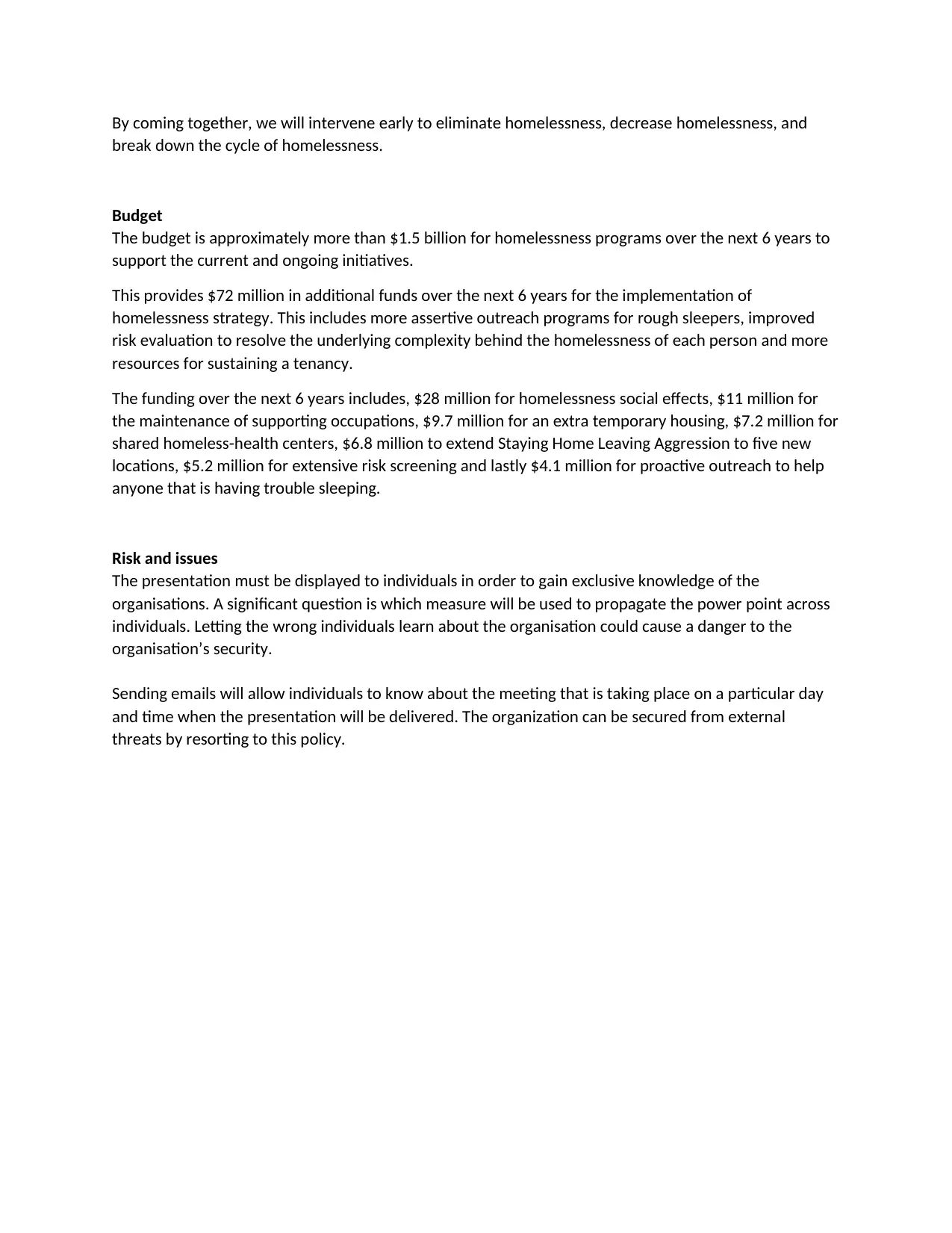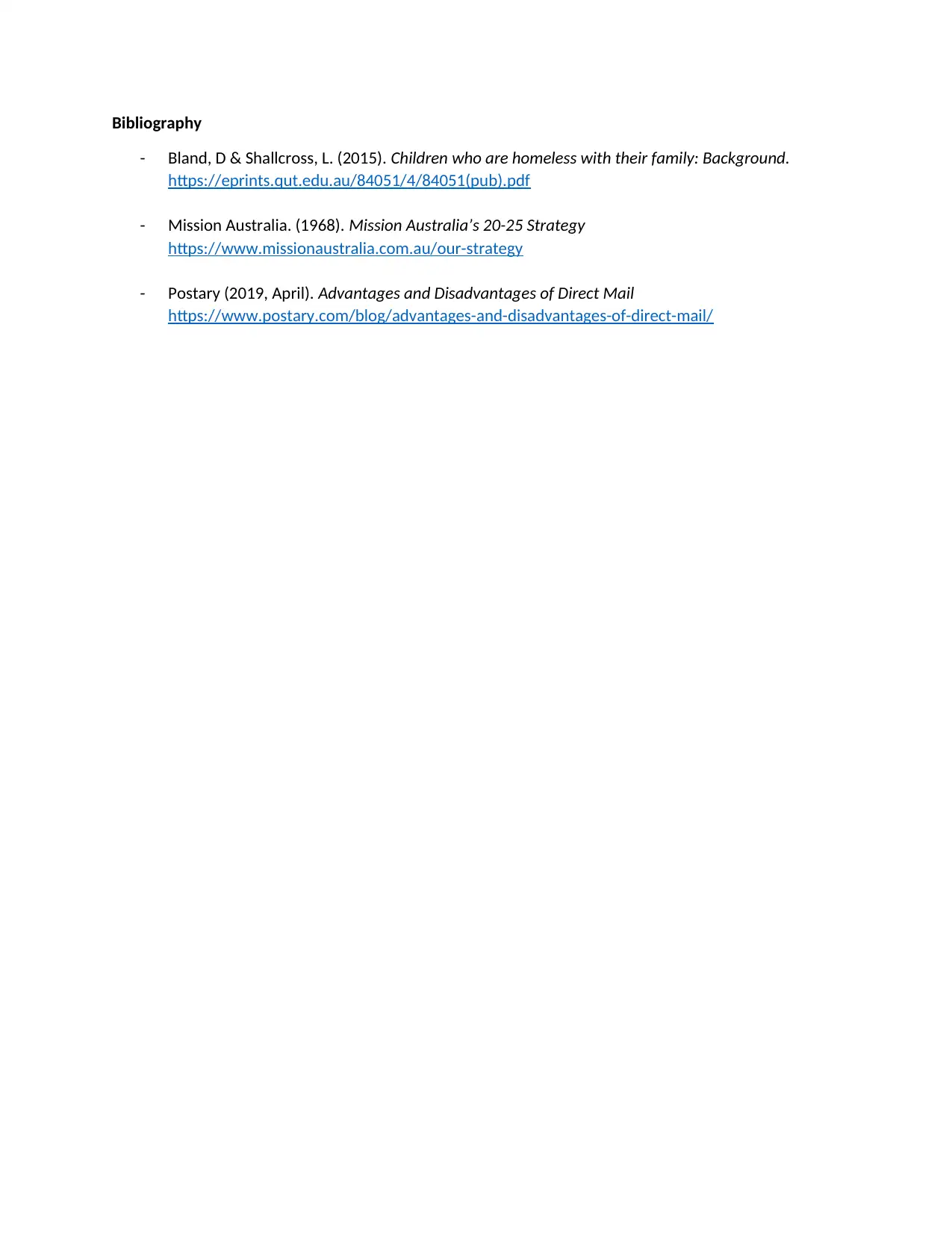Analysis of Promotional Strategies for a Homelessness Organization
VerifiedAdded on 2021/01/27
|4
|1441
|427
Report
AI Summary
This report provides an analysis of a homelessness organization's promotional strategy, focusing on key aspects such as the organization's background, communication objectives, target audiences, key messages, budget allocation, and potential risks. The organization aims to address homelessness through early intervention and prevention, with a focus on helping vulnerable individuals and families. The report outlines specific communication objectives, including delivering high-quality care and establishing the organization as a trusted service provider. It identifies target audiences like families, service users, and local authorities, while also highlighting key messages aimed at preventing and responding to homelessness. The budget allocation is also discussed. The report also addresses potential risks associated with the promotional strategy, such as security concerns regarding the dissemination of information and proposes solutions to mitigate these risks. The report concludes by emphasizing the importance of collaborative efforts and efficient systems to effectively combat homelessness.

Part A
Background of the organization
This organisation’s role is helping people find safe and affordable homes, helping vulnerable children
and families, encouraging disabled young people, helping mentally ill and disabled people, and so on.
They work precisely with people on their personal issues, discussing their needs, listening to their issues,
setting goals and advising them and helping them during difficult times. The core of their work is early
intervention and prevention.
“This organization has four strategic areas of focus articulate how they can move towards the aim of
eliminating homelessness and ensuring the prosperity of individuals and communities in need” (Mission
Australia, 1968). First is helping end homelessness in Australia. Through raising the impact of the
programs and advocating with their business partners, they are focused on helping to end homelessness
in Australia. Secondly is partnering to strengthen communities. They strongly believe that postcodes
should never restrict their futures, so they partner to improve communities through long- term positive
change. Thirdly, supporting people in need to thrive. By delivering and advocating for early intervention
programs that improve their well-being, they are enthusiastic about helping people who need to
succeed. Lastly, driving excellence. By continuously enhancing quality through everything they do,
sharing knowledge with others and multiplying their impact, they drive excellence. One promotional
strategy which is not effective is mail order marketing. “As it has to be delivered via the postal system,
direct mail has fixed costs. Product prices are high due to high advertisement rates and mailing
rates”(Postary, 2019). It also can have low response rates. It wastes money when you meet a customer
who is not interested or won’t respond to the service. Lastly, lack of personal contact. The producer and
the customer does not have direct personal contact with one another. The customers will not achieve as
much value from the service as desired. Therefore, they are more likely to go with another service.
Communication Objectives
The two objectives that I want to achieve through my promotional communication strategy is to deliver
the upmost care and support levels for individuals using the service and to play a vital role in the
community as a trusted provider of services for vulnerable people. Those objectives shows
homelessness organisation in practice.
Training all employees efficiently to work with the service users. This is to ensure that all employees
know and comprehend the level of care expected within the next couple of weeks. This will ensure that
employees are aware with the services provided. Additionally providing service users with access to
schooling, training and job opportunities. This will make sure that service users have opportunities to
express their needs within the organisation.
Regularly creating strong ties with the local authority and other contributors will provide a daily flow of
materials to key stakeholders. This allows the stakeholder’s to know what kind of service we are
providing. Additionally meeting contracts with the local’s authorities to give services for the services
users. This will routinely exhibit corporate contributions in the news media.
Background of the organization
This organisation’s role is helping people find safe and affordable homes, helping vulnerable children
and families, encouraging disabled young people, helping mentally ill and disabled people, and so on.
They work precisely with people on their personal issues, discussing their needs, listening to their issues,
setting goals and advising them and helping them during difficult times. The core of their work is early
intervention and prevention.
“This organization has four strategic areas of focus articulate how they can move towards the aim of
eliminating homelessness and ensuring the prosperity of individuals and communities in need” (Mission
Australia, 1968). First is helping end homelessness in Australia. Through raising the impact of the
programs and advocating with their business partners, they are focused on helping to end homelessness
in Australia. Secondly is partnering to strengthen communities. They strongly believe that postcodes
should never restrict their futures, so they partner to improve communities through long- term positive
change. Thirdly, supporting people in need to thrive. By delivering and advocating for early intervention
programs that improve their well-being, they are enthusiastic about helping people who need to
succeed. Lastly, driving excellence. By continuously enhancing quality through everything they do,
sharing knowledge with others and multiplying their impact, they drive excellence. One promotional
strategy which is not effective is mail order marketing. “As it has to be delivered via the postal system,
direct mail has fixed costs. Product prices are high due to high advertisement rates and mailing
rates”(Postary, 2019). It also can have low response rates. It wastes money when you meet a customer
who is not interested or won’t respond to the service. Lastly, lack of personal contact. The producer and
the customer does not have direct personal contact with one another. The customers will not achieve as
much value from the service as desired. Therefore, they are more likely to go with another service.
Communication Objectives
The two objectives that I want to achieve through my promotional communication strategy is to deliver
the upmost care and support levels for individuals using the service and to play a vital role in the
community as a trusted provider of services for vulnerable people. Those objectives shows
homelessness organisation in practice.
Training all employees efficiently to work with the service users. This is to ensure that all employees
know and comprehend the level of care expected within the next couple of weeks. This will ensure that
employees are aware with the services provided. Additionally providing service users with access to
schooling, training and job opportunities. This will make sure that service users have opportunities to
express their needs within the organisation.
Regularly creating strong ties with the local authority and other contributors will provide a daily flow of
materials to key stakeholders. This allows the stakeholder’s to know what kind of service we are
providing. Additionally meeting contracts with the local’s authorities to give services for the services
users. This will routinely exhibit corporate contributions in the news media.
Paraphrase This Document
Need a fresh take? Get an instant paraphrase of this document with our AI Paraphraser

The weakness of the objectives are when training staff some won’t understand what is being said due to
language barriers. Ways to overcome this is by repeating some words that you say, bringing in an
interpreter, using visuals methods of communications and being respectful. Speaking slower rather than
faster, clearly instead of aggressively. Also, it might not offer flexibility in providing individualised
services. A way to overcome this is offer similar services that they want or give information on other
services you know.
Target Audience/s
This is aimed at families, service users, local authority. Homeless families with children that are under
the age of 18 is coming out as the new face of homelessness. Making sure they receive the utmost care
and accommodation needed from the service that is being provided. Most homeless families that
involves an adult female parent/ guardian with their child/children are most likely to experience
homeless due to domestic violence. “Women and children are often specified as hidden homeless
because for the fear of violence, rape and abuse, they appear to be less seen than men and kept out of
sight, away from places where homeless people come together”(Commissioner for Children and Young
People, 2015). Women became the largest users of homelessness services they fled from domestic and
family violence situations. As for men, it was housing affordability or financial problems. Lastly, local
authorities have a legislative obligation to establish proactive approaches to the reduction of
homelessness, although this should not be treated as their only responsibility. They also provide
opportunities for partners to collaborate or work together to share their information and learn from one
another.
Key messages
My goal is to work together with other organisations to build a system that is able to prevent and
respond to homelessness more effectively. Only through the development of an efficient system which
recognises the complex nature we can help break down the cycle of homelessness and answer
rationally. Also helping individuals to live a more healthier and happy life.
For the next six years, the plan sets the course, focusing on preventive approaches that address the
fundamental causes of homelessness and early response measures that can decrease the longer term
effect of homelessness.
This strategy provides services on what we offer, a way of accessing the service and where they need to
go for any advice. We provide important, practical data and support. We are dependable and honest
and we like to put services users ahead and value their feedbacks and opinions. For our supporters, by
helping us, we have the opportunity to make improvements. To achieve this; helping our campaign by
signing petitions and help donate to us.
This strategy also includes an extensive consultation procedures with dozens of participants from a
number of agencies and organisations, people with a long-standing homelessness experience, and
individuals from groups with a higher risk of homelessness.
language barriers. Ways to overcome this is by repeating some words that you say, bringing in an
interpreter, using visuals methods of communications and being respectful. Speaking slower rather than
faster, clearly instead of aggressively. Also, it might not offer flexibility in providing individualised
services. A way to overcome this is offer similar services that they want or give information on other
services you know.
Target Audience/s
This is aimed at families, service users, local authority. Homeless families with children that are under
the age of 18 is coming out as the new face of homelessness. Making sure they receive the utmost care
and accommodation needed from the service that is being provided. Most homeless families that
involves an adult female parent/ guardian with their child/children are most likely to experience
homeless due to domestic violence. “Women and children are often specified as hidden homeless
because for the fear of violence, rape and abuse, they appear to be less seen than men and kept out of
sight, away from places where homeless people come together”(Commissioner for Children and Young
People, 2015). Women became the largest users of homelessness services they fled from domestic and
family violence situations. As for men, it was housing affordability or financial problems. Lastly, local
authorities have a legislative obligation to establish proactive approaches to the reduction of
homelessness, although this should not be treated as their only responsibility. They also provide
opportunities for partners to collaborate or work together to share their information and learn from one
another.
Key messages
My goal is to work together with other organisations to build a system that is able to prevent and
respond to homelessness more effectively. Only through the development of an efficient system which
recognises the complex nature we can help break down the cycle of homelessness and answer
rationally. Also helping individuals to live a more healthier and happy life.
For the next six years, the plan sets the course, focusing on preventive approaches that address the
fundamental causes of homelessness and early response measures that can decrease the longer term
effect of homelessness.
This strategy provides services on what we offer, a way of accessing the service and where they need to
go for any advice. We provide important, practical data and support. We are dependable and honest
and we like to put services users ahead and value their feedbacks and opinions. For our supporters, by
helping us, we have the opportunity to make improvements. To achieve this; helping our campaign by
signing petitions and help donate to us.
This strategy also includes an extensive consultation procedures with dozens of participants from a
number of agencies and organisations, people with a long-standing homelessness experience, and
individuals from groups with a higher risk of homelessness.

By coming together, we will intervene early to eliminate homelessness, decrease homelessness, and
break down the cycle of homelessness.
Budget
The budget is approximately more than $1.5 billion for homelessness programs over the next 6 years to
support the current and ongoing initiatives.
This provides $72 million in additional funds over the next 6 years for the implementation of
homelessness strategy. This includes more assertive outreach programs for rough sleepers, improved
risk evaluation to resolve the underlying complexity behind the homelessness of each person and more
resources for sustaining a tenancy.
The funding over the next 6 years includes, $28 million for homelessness social effects, $11 million for
the maintenance of supporting occupations, $9.7 million for an extra temporary housing, $7.2 million for
shared homeless-health centers, $6.8 million to extend Staying Home Leaving Aggression to five new
locations, $5.2 million for extensive risk screening and lastly $4.1 million for proactive outreach to help
anyone that is having trouble sleeping.
Risk and issues
The presentation must be displayed to individuals in order to gain exclusive knowledge of the
organisations. A significant question is which measure will be used to propagate the power point across
individuals. Letting the wrong individuals learn about the organisation could cause a danger to the
organisation’s security.
Sending emails will allow individuals to know about the meeting that is taking place on a particular day
and time when the presentation will be delivered. The organization can be secured from external
threats by resorting to this policy.
break down the cycle of homelessness.
Budget
The budget is approximately more than $1.5 billion for homelessness programs over the next 6 years to
support the current and ongoing initiatives.
This provides $72 million in additional funds over the next 6 years for the implementation of
homelessness strategy. This includes more assertive outreach programs for rough sleepers, improved
risk evaluation to resolve the underlying complexity behind the homelessness of each person and more
resources for sustaining a tenancy.
The funding over the next 6 years includes, $28 million for homelessness social effects, $11 million for
the maintenance of supporting occupations, $9.7 million for an extra temporary housing, $7.2 million for
shared homeless-health centers, $6.8 million to extend Staying Home Leaving Aggression to five new
locations, $5.2 million for extensive risk screening and lastly $4.1 million for proactive outreach to help
anyone that is having trouble sleeping.
Risk and issues
The presentation must be displayed to individuals in order to gain exclusive knowledge of the
organisations. A significant question is which measure will be used to propagate the power point across
individuals. Letting the wrong individuals learn about the organisation could cause a danger to the
organisation’s security.
Sending emails will allow individuals to know about the meeting that is taking place on a particular day
and time when the presentation will be delivered. The organization can be secured from external
threats by resorting to this policy.
⊘ This is a preview!⊘
Do you want full access?
Subscribe today to unlock all pages.

Trusted by 1+ million students worldwide

Bibliography
- Bland, D & Shallcross, L. (2015). Children who are homeless with their family: Background.
https://eprints.qut.edu.au/84051/4/84051(pub).pdf
- Mission Australia. (1968). Mission Australia’s 20-25 Strategy
https://www.missionaustralia.com.au/our-strategy
- Postary (2019, April). Advantages and Disadvantages of Direct Mail
https://www.postary.com/blog/advantages-and-disadvantages-of-direct-mail/
- Bland, D & Shallcross, L. (2015). Children who are homeless with their family: Background.
https://eprints.qut.edu.au/84051/4/84051(pub).pdf
- Mission Australia. (1968). Mission Australia’s 20-25 Strategy
https://www.missionaustralia.com.au/our-strategy
- Postary (2019, April). Advantages and Disadvantages of Direct Mail
https://www.postary.com/blog/advantages-and-disadvantages-of-direct-mail/
1 out of 4
Related Documents
Your All-in-One AI-Powered Toolkit for Academic Success.
+13062052269
info@desklib.com
Available 24*7 on WhatsApp / Email
![[object Object]](/_next/static/media/star-bottom.7253800d.svg)
Unlock your academic potential
Copyright © 2020–2025 A2Z Services. All Rights Reserved. Developed and managed by ZUCOL.




